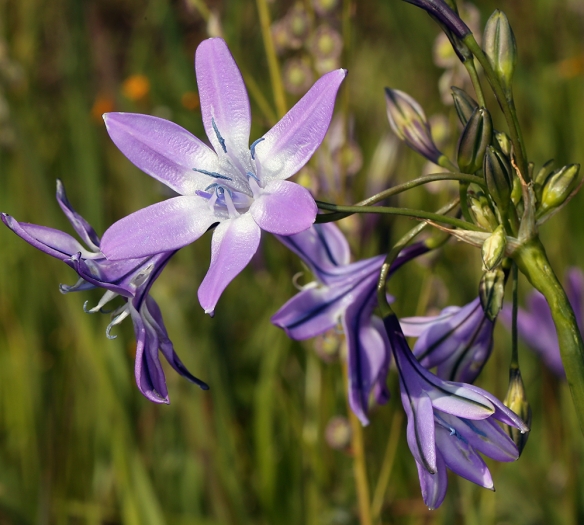Bridges’ Brodiaea
(Triteleia bridgesii)
Bridges’ Brodiaea (Triteleia bridgesii)
/
/

Steve Matson
CC BY 4.0
Image By:
Steve Matson
Recorded By:
Copyright:
CC BY 4.0
Copyright Notice:
Photo by: Steve Matson | License Type: CC BY 4.0 | License URL: http://creativecommons.org/licenses/by/4.0/ | Rights Holder: Steve Matson | Publisher: iNaturalist | Date Created: 2021-03-22T11:44:31-07:00 |

























Estimated Native Range
Summary
Triteleia bridgesii, commonly known as Bridges’ brodiaea, is a perennial herb native to the grasslands and open woodlands of California and Oregon, particularly thriving in serpentine soils. It is often found in areas with a Mediterranean climate, characterized by wet winters and dry summers. The plant typically grows to a height of 12-18 inches (30-45 cm) with long, erect green stems that branch near the top. From late spring to early summer, it produces clusters of bright purple or lavender tubular flowers that open into six-pointed star shapes, which are highly showy and attract pollinators such as bees.
Bridges’ brodiaea is valued for its vibrant and striking blooms, making it a popular choice for ornamental planting in rock gardens, borders, and naturalized areas. It is relatively low maintenance, requiring minimal water once established, and is best suited to well-drained soils with full sun to part shade exposure. While it is drought-tolerant, it appreciates occasional watering during prolonged dry periods. There are no major disease or pest problems associated with this species, but it can be sensitive to overwatering and poor drainage.CC BY-SA 4.0
Bridges’ brodiaea is valued for its vibrant and striking blooms, making it a popular choice for ornamental planting in rock gardens, borders, and naturalized areas. It is relatively low maintenance, requiring minimal water once established, and is best suited to well-drained soils with full sun to part shade exposure. While it is drought-tolerant, it appreciates occasional watering during prolonged dry periods. There are no major disease or pest problems associated with this species, but it can be sensitive to overwatering and poor drainage.CC BY-SA 4.0
Plant Description
- Plant Type: Herb
- Height: 0.5-1.5 feet
- Width: 0.5-1 feet
- Growth Rate: Moderate
- Flower Color: Pink, Purple
- Flowering Season: Spring, Summer
- Leaf Retention: Deciduous
Growth Requirements
- Sun: Full Sun, Part Shade
- Water: Medium
- Drainage: Medium
Common Uses
Border Plant, Butterfly Garden, Deer Resistant, Low Maintenance
Natural Habitat
Native to grasslands and open woodlands of California and Oregon with a Mediterranean climate
Other Names
Common Names: Bridges’ Triteleia
Scientific Names: , Triteleia bridgesii, Brodiaea bridgesii, Hookera bridgesii,
GBIF Accepted Name: